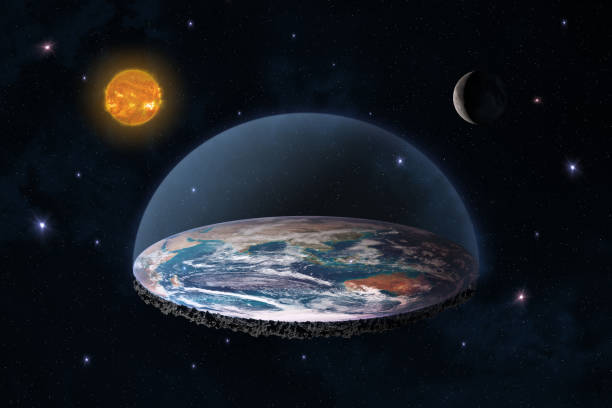Throughout history, many ancient cultures held the belief that the Earth was flat. These civilizations developed intricate cosmologies, myths, and explanations for the nature of the world based on their observations and spiritual understandings. While modern science has since provided a different perspective, exploring these ancient flat Earth beliefs offers fascinating insights into how early societies interpreted their surroundings.
In this post, we will examine several ancient civilizations that embraced the idea of a flat Earth, their cosmological views, and how these beliefs shaped their cultures.
1. The Mesopotamians: The World as a Floating Disk
One of the earliest recorded flat Earth cosmologies comes from ancient Mesopotamia, the land between the Tigris and Euphrates rivers, home to the Sumerians, Akkadians, and Babylonians.
- The Cosmic Ocean & the Firmament
Mesopotamians envisioned the Earth as a flat, circular disk floating on a vast cosmic ocean. Above the Earth was a solid dome (the “firmament”) that held back the heavenly waters, with the stars, moon, and sun moving across its surface. - The Underworld Beneath
Below the Earth was the underworld, a shadowy realm where the dead resided. This three-layered universe—Heaven, Earth, and Underworld—was central to Mesopotamian mythology. - Enuma Elish & Creation Myths
The Babylonian creation epic, Enuma Elish, describes how the god Marduk split the body of the primordial goddess Tiamat to form the heavens and the Earth, reinforcing the idea of a flat world beneath a domed sky.
2. The Egyptians: A Flat Earth Surrounded by Mountains
Ancient Egyptian cosmology also depicted a flat Earth, shaped by their observations of the Nile and the surrounding deserts.
- The Sky Goddess Nut & the Earth God Geb
Egyptians believed the Earth (personified by Geb) was a flat plane, while the sky (Nut) was a curved goddess arching over the land. The sun god Ra traveled across her body by day and through the underworld at night. - The Circular Ocean & the Primordial Mound
The Earth was thought to be surrounded by Nu, the endless waters of chaos. At the center was the primordial mound, the first land to emerge from the waters, mirroring the annual flooding of the Nile.
3. The Hebrews: A Flat Earth in Biblical Cosmology
Many ancient Hebrew texts describe a flat Earth cosmology, which influenced early Judeo-Christian beliefs.
- The Firmament & the Waters Above
The Book of Genesis describes a “firmament” (raqia) separating the “waters above” from the “waters below,” suggesting a flat Earth beneath a solid dome. - Pillars of the Earth
Passages in the Bible (e.g., Job 9:6, 1 Samuel 2:8) reference the Earth having “pillars” or foundations, implying a stationary, flat plane. - The Four Corners of the Earth
Phrases like “the four corners of the Earth” (Isaiah 11:12) further reflect a flat, quadrangular worldview.
4. The Greeks: Early Flat Earth Thinkers
Before the rise of spherical Earth theories (popularized by Pythagoras and later Aristotle), many early Greek philosophers believed in a flat Earth.
- Homer’s Worldview
In The Iliad and The Odyssey, Homer describes a flat, disk-shaped Earth surrounded by the River Ocean. - Anaximander’s Cylindrical Earth
The pre-Socratic philosopher Anaximander proposed that the Earth was a flat cylinder floating freely in space, with the known world on its upper surface. - Hesiod’s Cosmic Order
The poet Hesiod wrote of a flat Earth with the heavens above and Tartarus (the underworld) below, held in place by cosmic forces.
5. The Norse: A Flat World Tree Cosmology
Viking-age Scandinavians believed in a flat, disk-shaped Earth as part of their intricate Norse mythology.
- Yggdrasil & the Nine Realms
The Norse saw the universe as a great tree (Yggdrasil) with different realms, including Midgard (Earth), resting on its branches. Midgard itself was a flat land surrounded by an impassable ocean. - The Serpent Jörmungandr
The world serpent Jörmungandr was said to encircle Midgard, biting its own tail—a symbol of the world’s boundaries.
6. The Chinese: Square Earth, Round Heaven
Ancient Chinese cosmology often depicted a flat, square Earth beneath a round, domed heaven.
- The Gai Tian Model
Early Chinese astronomers believed in the “Gai Tian” (Heavenly Cover) model, where the sky was a round canopy over a flat, square Earth. - The Four Seas & the Central Kingdom
China viewed itself as the “Middle Kingdom,” surrounded by four seas and distant lands inhabited by mythical beings.
Conclusion: A Shared Vision of a Flat World
These ancient civilizations, separated by vast distances and time, all developed remarkably similar flat Earth cosmologies. Their beliefs were shaped by direct observation—horizons appearing flat, the sun and stars moving overhead—and reinforced by myth and religion.
While later scientific discoveries led to new understandings of the Earth’s shape, these early cosmologies remain a testament to humanity’s enduring quest to explain the nature of our world.



Leave a Reply